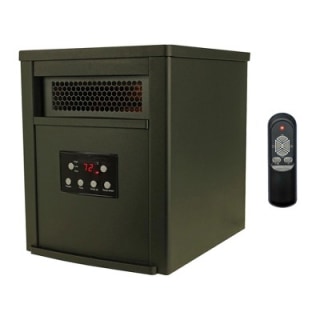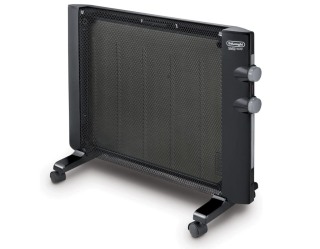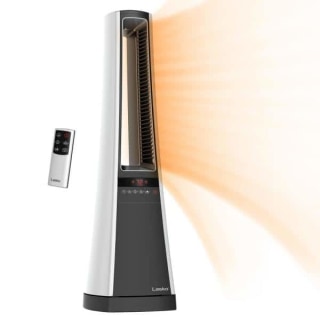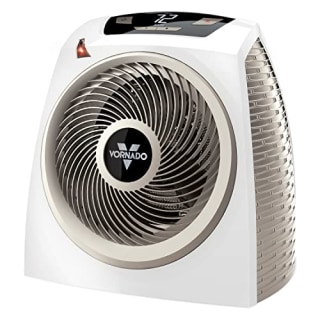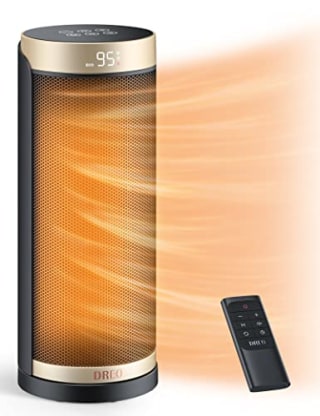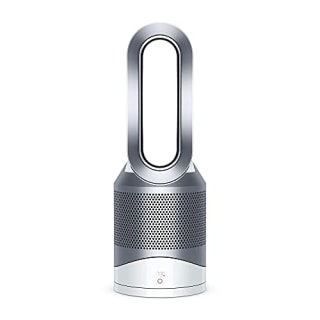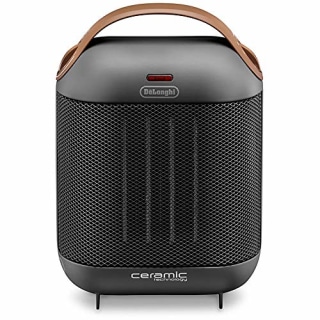
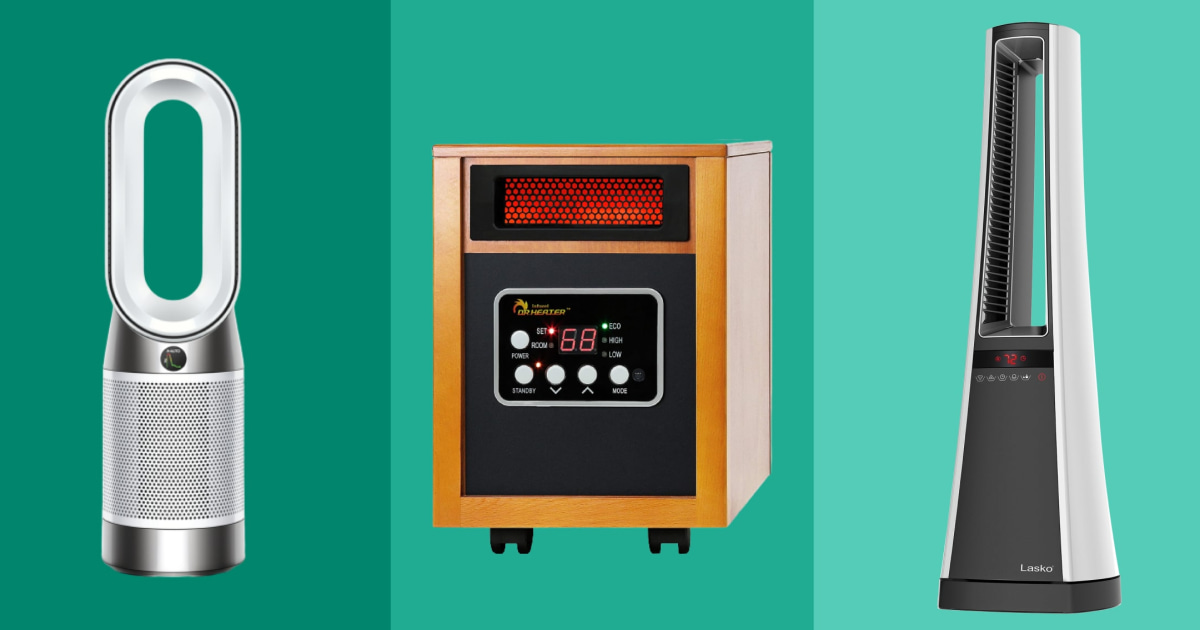
Space heaters can be a fast and economical way to warm up your home when temperatures dip — and they can be a beneficial tool to keep on hand in case of emergencies. Whether it’s a drafty bedroom or outside on the patio during a cool night, these portable devices allow you to bring an effective boost of heat wherever you need it.
SKIP AHEAD The best space heaters | How to shop for a space heater | Why trust NBC Select?
“Outdoor space heaters are a great way to warm up areas of your yard or patio so that you can still get together with friends and family even as the days get cooler,” said Bailey Carson, home-care expert at Angi.
To determine the best space heater for you, we spoke to home and safety experts about the benefits of space heaters, what features to look for when shopping for one and how to use them safely.
The best space heaters of 2024
To help give you an idea of the space heater choices out there, we rounded up expert-recommended options at various price points. Each one carries either the ETL or UL label, which means they were tested by an independent testing agency to ensure they meet the Underwriters Laboratory requirements for safety. Experts also share their favorite space heaters from brands like Dyson, Vornado, Lasko and more.
Best radiant space heater: Dr. Infrared Heater Portable Space Heater
Glenn Wiseman, sales manager of Top Hat Home Comfort Services in Ontario, recommended this portable infrared model for its dual heating system and built-in thermostat that ranges from 50 to 85 degrees Fahrenheit. The energy-saving space heater offers 1,500 watts and is powered through a electric cord with 120 volts, which can evenly heat a 150-square-foot room, he said. It also has an automatic 12-hour shutoff timer.
Best radiant space heater for big rooms: Lifesmart 6 Element Heater
For spaces ranging up to 150 square feet, Arie Van Tuijl, a licensed home inspector and founder of home-maintenance website Home Inspector Secrets, recommended this Lifesmart infrared space heater, which has a maximum setting of 1500 watts. It includes a remote, a 12-hour timer and three different heat modes. It also includes an ”eco setting,” which the brand says maintains a constant 68-degree temperature using less power for when you want to bring it into a smaller room.
Best panel radiant space heater: De’Longhi Mica Thermic Panel Heater
The nice thing about this lightweight, compact space heater is that it can either be mounted on the wall or set on the floor. It also comes with wheels so you can easily move it from room to room. It packs a powerful punch with 1500 watts of heat and has an adjustable thermostat and multiple heat settings so you can personalize for your comfort, according to the brand.
Best convection space heater: KopBeau 1500W Oil Filled Radiator Space Heater
KopBeau’s indoor space heater is Van Tuijl’s overall pick for bedrooms. This oil-fueled convection model has four heating modes: low, medium, high and eco mode, the latter of which the brand says cycles between the highest and lowest settings to maintain your room temperature while reducing energy consumption. The heater also has a 24-hour on/off timer with a remote control for ease of use, according to KopBeau.
Best wall-mounted convection space heater: Envi 120v Plug-in Electric Panel Wall Heater
Van Tuijl recommends this wall-mounted, convection space heater, which has a temperature controlling thermostat and the brand’s Wall-Sens technology, which cuts out the power for safety when the unit is removed from the wall, according to the brand. The unit, which Envi says heats rooms between 130 and 150 square feet, is just 2 inches thick and can automatically dim the power light in dark rooms.
Best tower convection space heater: Lasko Electric Tower Heater
This Lasko space heater has a bladeless design at a more affordable price than similar brands, like Dyson. Lasko says it’s equipped with a slew of safety features, including a safe touch surface and an automatic 8-hour shut-off switch. With its quiet oscillating mode, this tower can evenly distribute heat in rooms up to 300 square feet, according to the brand.
Best combination space heater: Vornado AVH10 Vortex Heater
The AVH10 Vortex Heater from Vornado, a brand that Wiseman says has good safety standards, also has two heat settings and a fan-only option, along with an adjustable thermostat. It can heat rooms up to 300 square feet and features a hidden cord storage compartment at the bottom of the heater, according to Vornado.
Best energy-efficient combination space heater: Dreo Indoor Space Heater
Van Tuijl recommends this convection space heater from Dreo due to its easy-to-use touch screen panel, strong heat output and remote control capabilities. This model has three heating modes and a digital thermostat that ranges from 41 degrees to 95 degrees Fahrenheit. It also has a timer that automatically shuts off after 12 hours, and the remote lets you turn the unit off from up to 26 feet away, according to the brand.
Best luxury space heater: Dyson Pure Hot + Cool HP10 Fan
The bladeless Dyson Pure Hot + Cold is a remote-controlled combination heater, fan and air purifier all in one, according to the brand. The remote-controlled fan can oscillate up to 350 degrees and offers different modes, including a backward airflow mode that diverts air through the rear of the space heater, continuing its purifying effect without the draft, according to the brand. It also includes a nighttime mode that uses a dimmed display, according to Dyson. Wiseman noted this space heater is “substantially quieter” than many other models and can regulate indoor air quality: using a HEPA-style filter, it can capture 99.97 percent of particles that are 0.3 microns in size, says the brand. The unit can also connect to Wi-Fi so you can control your machine remotely and schedule when your air purifier is on, using the Dyson Link app.
Best budget space heater: Lasko Oscillating Ceramic Heater
The most affordable option on this list, the portable Lasko Oscillating Ceramic Heater can be a worthwhile option if you’re on a budget. Lasko says this space heater can heat rooms up to 300 square feet and offers two heat levels — low heat and high heat — along with a cool air fan setting. You can also use the thermostat knob to both turn on the unit and have it shut off automatically once a certain temperature has been reached (though the knob itself doesn’t list actual numbers), according to the brand.
Best safety features: DeLonghi Capsule Electric Space Heater
This compact and portable heater from DeLonghi packs 1500 watts of power and is great for all-season use; it has heat settings for the winter and a cooling, fan-only functionality that’s perfect for summertime, according to the brand. You can customize your heat settings using the adjustable thermostat and also carry the heater with you using the cool-touch handle at the top. This heater also has a number of built-in safety features that make it easier to have around a busy home, including a two-stage protection against overheating and an internal tip-over switch that automatically shuts the heater off if it falls over, says Delonghi.
How to shop for a space heater
The first step when shopping for a space heater is determining the size of the area you plan to warm. Van Tuijl generally recommends buying a space heater that is in the 500-1000 watts range for smaller rooms (which are typically considered 120 square feet or less), and between 1,000 and 1,500 watts for larger rooms.
As a general rule of thumb, according to indoor air-quality company Sylvane, you need roughly 10 watts of heating power for every square foot of floor area in the room. This means that a 1,500-watt space heater can be the primary heat source for an area measuring up to 150 square feet. Carson also says it’s important to make sure your heater is compatible with your space: “If you’re shopping for an indoor space heater, stay away from gas and propane models. If you need a heater for your patio, a gas model may be a good option as long as it’s the correct size. Do a lot of research and read the manufacturer’s guidelines.” Some other key features to look out for while shopping include:
- Noise level. Some units are louder than others. If you’re shopping for a bedroom or home office, that’s something to keep in mind. One resource for finding devices that are especially quiet is Quiet Mark, which tests and awards products based on their noise output.
- Safety features. Space heaters can be potential fire hazards, so don’t overlook any built-in features designed to lessen that chance. “Make sure to buy one that has protective grills as well as auto-shut off capabilities [in case] the heater tips over or overheats,” said Carson. If you’ve had your space heater for a while, she recommended double-checking for an auto-shut off feature since some older models may not have one.
- Warranty. Don’t forget to look into warranty options. “This way, you can protect your investment in case anything happens,” Wiseman noted. A quality space heater will have a three-year warranty.
- Energy efficiency. Space heaters are generally more energy efficient than central heating since you’re only heating up the room and some space heaters are also more energy efficient than others. Since space heaters don’t have Energy Star ratings — which independently certifies a product’s energy efficiency — the easiest way to determine if your unit conserves energy is by checking whether it has features like an adjustable thermostat and auto shut-off option that can maintain a certain temperature and prevent a room from overheating, according to the Department of Energy.
Meet our experts
At Select, we work with experts who have specialized knowledge and authority based on relevant training and/or experience. We also take steps to ensure that all expert advice and recommendations are made independently and with no undisclosed financial conflicts of interest.
- Bailey Carson is a home-care expert at Angi
- Glenn Wiseman is the sales manager of Top Hat Home Comfort Services in Ontario
- Arie Van Tuijl is a licensed home inspector and founder of home-maintenance website Home Inspector Secrets
- Joel Hawk is the principal engineering manager at Underwriters Laboratories
Why trust NBC Select?
Mili Godio is an updates editor at Select who covers a wide range of topics including the best meal delivery services, the best vacuums and more. Ashley Morris is an associate SEO reporter for NBC Select, covering subjects like the best tower fans and the best sales each week. For this article, Godio spoke to industry experts about how to find the best space heaters and what to keep in mind while shopping.
Catch up on Select’s in-depth coverage of personal finance, tech and tools, wellness and more, and follow us on Facebook, Instagram, Twitter and TikTok to stay up to date.
